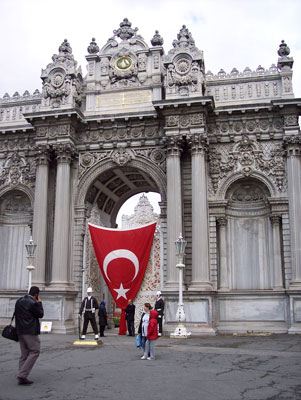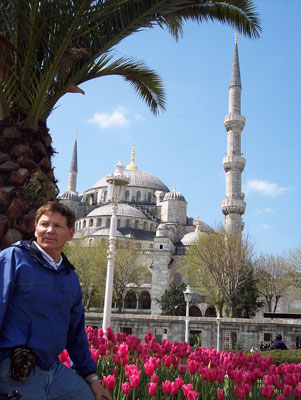Istanbul and Bodrum
This item appears on page 67 of the November 2009 issue.
by Randy Keck (part 3 of 3 on Turkey)
The final portion of my April ’09 exploration of Turkey began with a short drive from Bursa to Yalova, where we boarded a vehicular ferry for the 40-minute crossing to one of the world’s most populous (17 million) and most intriguing cities, Istanbul. The city is literally the crossroads between east and west, with the Bosporus dividing the city into two sectors, one in Europe and the other in Asia.
Istanbul’s four main districts require a minimum of four to five active touring days to properly explore, so our allotment of 1½ days allowed time for only a few highlights. Our itinerary was based on having free time for exploring Istanbul at our own pace, providing the opportunity to utilize the excellent, low-cost tram system.
Strolling Istanbul
On the afternoon of our arrival, my tour mates Betsy, Art and I, for the first time sans guide, departed our classy digs, the Elite World Hotel, conveniently located near the city’s Taksim Square transport hub. We were bound for famous Dolmabahçe Palace via a walking excursion along Beyog˘lu’s popular pedestrian promenade, Istiklal Caddesi.
Strolling Istiklal at once provides an architectural glimpse of the city’s historic past and the broad weave of the thriving commercial offerings of the area today.
My final evening in Istanbul, a friend took me to a backstreet coffee house restaurant off Istiklal, where she used to work as a tarot card reader. This glimpse of the Berkeleyesque exuberance of the youthful local Turks in residence was a brief return to the ’60s but with accented English and electronic upgrades.
Dolmabahçe Palace
The staggering opulence of Dolmabahçe Palace, built by Sultan Abdül Mecit, is surprising in that it was completed in 1856 when the Ottoman Empire was in decline.
The most striking feature is the Ceremonial Hall, designed to hold 2,500 people and adorned with a chandelier reputed to be the heaviest in the world. The palace, which features a glittering array of large chandeliers, can be visited only on guided tours of which there are two, the main one, “Selamlik Tour,” and the “Harem Tour.” I recommend combining both.
Blue Mosque and Hagia Sophia
Sultanahmet, the center of ancient Istanbul, features the famous, must-visit adjacent duo of the 17th-century Blue Mosque and 1,400-year-old Hagia Sophia (Ayasofya). You can easily explore the sacred Blue Mosque on your own, but for complex Hagia Sophia I strongly recommend hiring one of the sanctioned local guides at the entrance.
Hagia Sophia was the centerpiece of the sixth-century Byzantine capital and is regarded as among the world’s greatest architectural achievements, having retained a strong influence on architectural styling for many centuries.
A full article could be written on each of these important treasures. Unfortunately, our limited time did not allow for our visiting the massive, 15th-century Topkapi Palace complex. Our tour guide had preadvised that he would choose Dolmabahçe over Topkapi if only one could be visited, so we chose accordingly.
The Grand Bazaar
We completed our day of touring with a visit to the nearby Bazaar Quarter, wandering the streets and alleyways of the Grand Bazaar and smaller Spice Bazaar. Commercial activity poured out of the shops and stalls beckoning buyers. Some things never change, even over the centuries, and trade sits unchallenged atop the list.
To my great regret, time did not allow for the highly touted Bosporus cruise, an experience that tops my list for my next visit to Istanbul.
Bodrum beckons
I had arranged for a few days on my own at the highly popular Aegean seaside resort of Bodrum at the end of my “Best of Turkey” tour, hosted by FLO-USA (an advertiser in ITN) and Turkish Airlines. My base was a small hillside boutique hotel, El Vino, a short walk from the village center.
The service at El Vino was impeccable, from the lofty restaurant with expansive views overlooking Bodrum to the poolside, where breakfasts and daily happy hours were enjoyed. Poolside, I met several interesting, convivial travelers over the course of two afternoons.
Majestic St. Peter’s Castle
Bodrum’s primary landmark is the historic, 15th-century St. Peter’s Castle, which looms large over an entirely colorful harbor lined with rows of Turkish gulets and impressive, designer teak yachts, most available for charter.
My first afternoon, I undertook a leisurely self-guided exploration of the waterfront St. Peter’s fortress, whose five towers represent the nationalities of its past inhabitants. Having survived a checkered history, today it is well known for its displays of undersea treasure recovered from shipwrecks off the coast of Turkey over a period of many centuries.
Turkish beach & bath delights
My second afternoon, I took a local minibus to the village of Bitez and its local beach, which I had been advised was the best swimming beach in the Bodrum area. Bitez Beach did not disappoint and, with no timetable, I thoroughly enjoyed swimming and lounging in the spring sun.
During the course of the afternoon, I learned that many Brits have discovered Bitez and have second homes in the area.
On my final morning in Bodrum, I finally managed to partake of the traditional Turkish bath experience, at the well-known local hamman near the village center. The entire hour-plus regimen, including a 20-minute massage, was good value at ONLY $26.
Before you go…
For information on a wide range of tour options for international destinations, contact Turkey specialist FLO-USA (Lake Mary, FL; 888/435-6872).
Turkish Airlines (800/874-8875) offers the largest range of flight options from North America to Turkey.
Keck's Beyond the Garden Wall
❝The honor, morality, loyalty and convictive spirit of the present provide an antidote for the certain challenges of an increasingly uncertain planet. ❞
— Randy’s assessment of Turkey’s coping prospects for the future world


